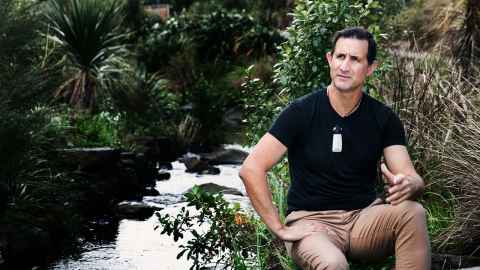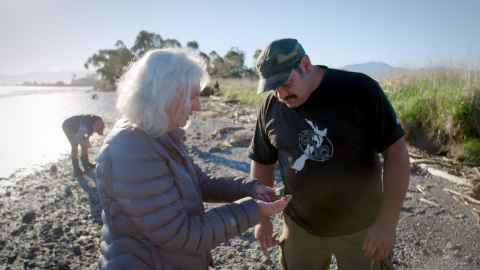New and ancient lens for healthy rivers
24 February 2021
Researchers have articulated a way to look at and look after our fresh waterways founded on Matauranga Māori.



When floodwaters pounded the Bay of Plenty township of Matatā with boulders and logs to devastating effect in 2005, three marae went unscathed.
The explanation was a Māori pūrākau, or traditional narrative, warning of danger from a taniwha, according to Dan Hikuroa, a senior lecturer in Māori Studies at the University of Auckland. The story told of a taniwha in the form of a lizard, with its head lying in the headwaters of a stream, while its tail flicked from side to side.
The narrative condensed hundreds of years of local knowledge, with the flicking tail signifying a low-lying section of the stream on the Rangitaiki Plains that was prone to changing course during flooding, Hikuroa wrote in the Journal of the Royal Society of New Zealand in 2017.
That warning helped local iwi to avoid siting marae in hazardous spots, he said.
The anecdote illustrates the trove of indigenous knowledge that can come to the rescue of Aotearoa New Zealand’s troubled waterways, according to earth systems scientist Hikuroa and collaborators such as river scientist Professor Gary Brierley and anthropologist Dame Anne Salmond.
Their ambition is even broader: changing the way a nation and its citizens engage with rivers, switching from what they call a “command and control” model, where nature is viewed as a resource to be exploited by humans, to a “more than human” approach, where a river is valued for being a river. It’s a campaign they’re carrying out through articles, speeches, projects and case studies, including a project to restore the Waimatā River in Gisborne – with fencing and planting to protect the water, community engagement to draw in all the interested parties, and detailed research to learn the stories of the waterway.
In 2009, a Maori elder named Turama Hawira (Ngāti Rangi) captured both the woes of our waterways and a Māori sense of connection with a river, in a statement to the Waitangi Tribunal about the Whanganui River: “It is with huge sadness that we observed dead tuna (eels) and trout along the banks of our awa tupua (ancestral river.) The only thing that is in a state of growth is the algae and slime. Our river is stagnant and dying. `E rere kau mai te awa nui mai i Te Kāhui Maunga ki Tangaroa. Ko au te awa, ko te awa ko au.’ (The great river flows from the gathering of mountains to the sea. I am the river, the river is me.) If I am the river and the river is me – then emphatically, I am dying.”
The lead content was high enough to mine.
Waiwhetū in Wellington, once known as the nation’s most toxic stream and even today still struggling, is cited in a Ministry of Environment report in 2020 as an example of the nation’s freshwater contamination.Running from Hutt Valley’s eastern hills to the Hutt River as it enters Wellington Harbour, Waiwhetū served as an industrial drain for decades, reportedly changing colour to yellow or blue according to a factory’s wool dyes, and catching fire in the 1970s. As late as 2006, it was contaminated with levels of copper, zinc and lead that exceeded environmental guidelines by more than 90 times.
“The lead content was high enough to mine,” Te Rira Puketapu, a Te Āti Awa elder, told the ministry. Restoration efforts such as riverside planting and removing industrial sludge and weed have encouraged life back into the waterway but storm water discharge keeps adding contamination and “it will never be back to how it was,” said Puketapu. “We can’t have our children swimming there, it’s a really sad story.”
How to get back in balance with nature? The clues are in Māori cosmology, according to Salmond, a devoted environmentalist and a Distinguished Professor of Māori Studies and Anthropology, internationally known for her books on Māori life and cross-cultural encounters in the Pacific.
That’s why her Kosmos lecture in Berlin to honour the 250th anniversary of the birth of the Prussian naturalist and explorer Alexander von Humboldt, in 2020, you could hear Salmond explaining Rangi, Papa – and how an indigenous world view was in synch with cutting-edge science.

She explained the beginning of the cosmos this way:"… the world begins with a surge of energy, followed by knowledge, thought, memory, desire. And it wasn’t until hau ora and hau tipu, the winds of growth and life, blew through the cosmos that Rangi and Papa, the earth mother and sky father, emerged, and followed by stars, plants, animals and people.
"In this way of thought, and this way of being, all the world is a vast kin network powered by the winds of life and growth -- one living system, one source of life. And in this relational cosmos, mind and matter are not split, nor are knowledge and desire.
"Space-time is a spiral. Life returns to the ancestral source and then spins out again into the future. Earth and sky, stars, sea, winds, people and other life forms are linked together, driven by mutual exchanges. When balance is achieved, families, communities and eco systems alike are in a state of aura – health, prosperity, and well-being.
“If reciprocity fails, however, entire networks and their members begin to fail and become mate, or sick, unhealthy and dysfunctional. This can apply to individuals, to families, to communities, to countries, perhaps even to the planet.’’
To Salmond, this understanding of a “dynamic, pulsing cosmos” and the inter-connectedness of living things fits with the latest science on complex networks and is underscored by the inter-linked collapses of socio-ecosystems.
A Māori view of rivers and nature is finding increasing sway in government policies and legislation. The rub is the “collision of cultures” – one of Salmond’s main topics of investigation down the years -- as those efforts butt up against individualism, property rights, profit incentives, and the commodification of nature.
In a breakthrough in 2014, the government’s National Policy Statement for Freshwater Management acknowledged “Te Mana o te Wai” in setting freshwater objectives, recognising a range of tangata whenua values. That same year, unprecedented language in legislation recognized the natural, historical and spiritual value of the rugged Te Urewera area in the North Island – and gave it its own legal identity.
In 2017, famously, New Zealand became the first nation to grant legal rights to the nation’s longest river, the Whanganui. Two people – one appointed by the Crown and one appointed by the Whanganui iwi – act for the river to protect its health and well-being. However, at the same time as the Whanganui and Te Urewera legislation gave prominence to a Māori view, the law also entangled a different way of seeing the world.
The framing is still anthropocentric… since it defines the river as a legal person
“The framing is still anthropocentric… since it defines the river as a legal person,” Hikuroa, Salmond and Brierley wrote in an article, Let the Rivers Speak, published in 2020 in Policy Quarterly. “In effect, this diminishes the mana of the Whanganui, since, in ancestral understandings, waterways emerge from the exchange of rain and mist between sky and earth, and are more ancient and powerful than people,” they said.
The naming of human representatives for the Whanganui could be seen as limiting the river’s agency, as when a guardian is appointed for a child or someone incapacitated.
“Likewise, framing the mana of the river as ‘rights’ fails to respect the principal of reciprocity, which aims to generate ora [health or well-being] through balanced exchange,” they argued.
Legal framings have inspired attempts to explore what it might mean for a river to have its own life, on its own terms, with its own rights to health and well-being.
One Monday morning in autumn this year, Hikuroa was pointing to a spot on the Auckland waterfront, at Ōrākei Domain, adjacent to Ōkāhu Bay. “That,” he said, “is where a river was buried alive.”
He was talking about a stream long since entombed in concrete pipes underground – in the same way that Wai-Horotiu, a largely forgotten stream, runs under Auckland’s Queen Street. It would be Hikuroa’s dream for the Ōkāhu Bay stream to be restored – the feasibility studies have been done – and, if Seoul can restore a river in the heart of the city, then isn’t it conceivable that Auckland could do the same for Queen Street?
In a 2018 paper, inspired by Māori ideas, Brierley, Hikuroa, Salmond and their co-authors came up with seven 'rights' that a river, valued for its own sake, rather than as a resource for exploitation, might enjoy:
• a right to flowing water
• a right to transport sediment
• a right to be diverse
• a right to adjust
• a right to evolve
• a right to operate at the catchment scale
• and a right to be healthy
Brierley’s book, Finding the Voice of the River, traverses rivers from the Ganges to the Rio Grande, surveys their frequently parlous states, and makes the case for a 'more than human' approach.
"Although moves towards an era of river repair have taken place in recent decades, such that images of rivers choked by toxic waste products or use of channels as drains and open sewers are increasingly distant memories in many parts of the world, elsewhere such realities continue to this day,” he writes. "It is increasingly clear that the technical skills that brought about the degradation of river systems will not, in their own right, provide the required approach to bring about the scope and scale of river repair that is necessary. A different way of thinking is needed.’’
For her part, in her book Tears of Rangi: Experiments across Worlds, Salmond wrote: “… the most intransigent obstacles to solving environmental (and other) challenges lie at the level of pre-supposition.
For waterways, the assumption that they were created to serve human purposes drives towards their degradation and destruction.” She has urged the public to “treat our rivers as taonga, not toilets.”
Taonga is often translated as ‘treasure’ or ‘treasures’. While that translation isn’t wrong, it doesn’t fully capture the meaning of the word and a better understanding is the active ‘to be treasured,’ according to Hikuroa. “Based on our behaviour and infrastructure, it doesn’t seem New Zealand views water as taonga,” he says. “Simply put, we don’t treasure our water, and we should.”
Read more on healthy waterways in The Conversation: Stopping the zombie rivers.